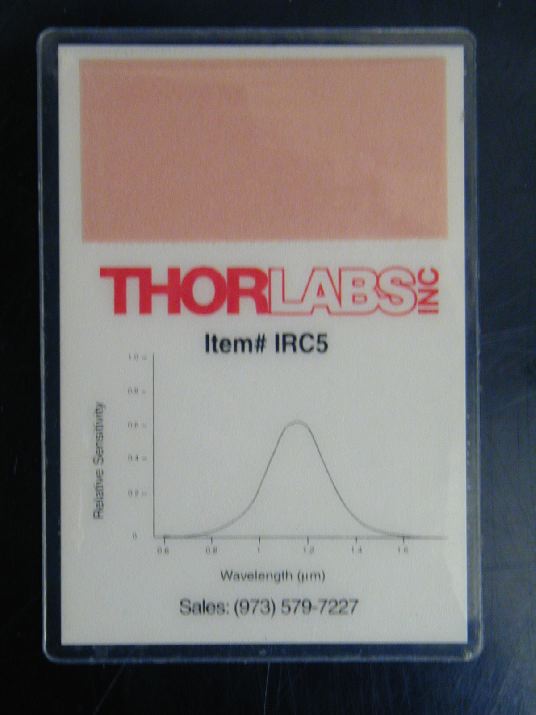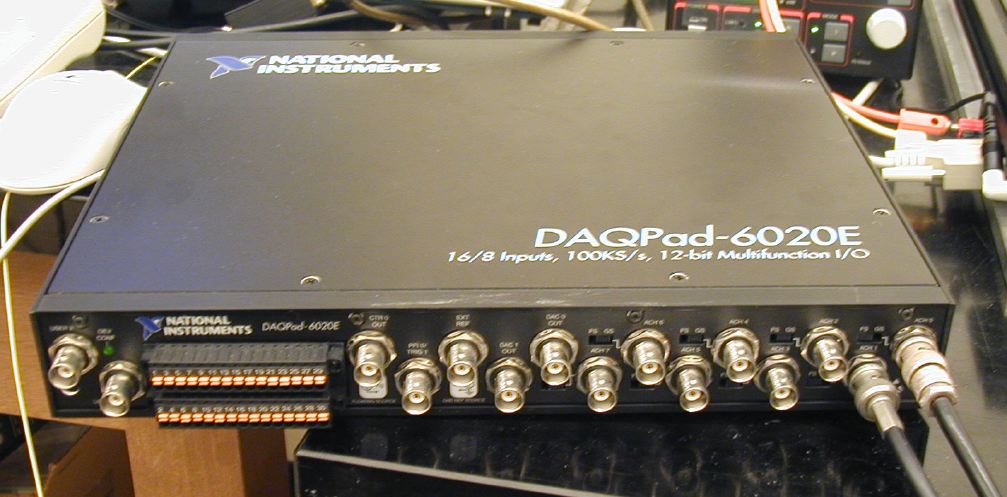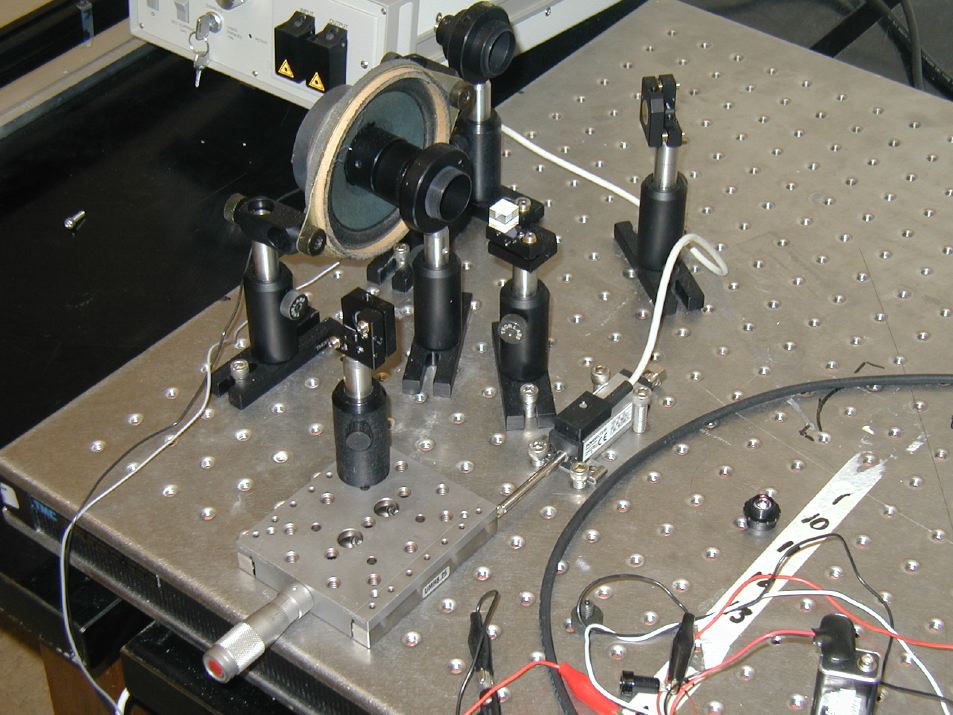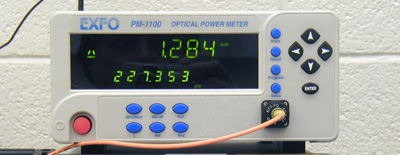
The model is a Thorlabs IRC5. The sensitivity of the IRC5 extends a little farther into the infrared than does that of the IRC3, for which specifications are available in PDF (16k).
The card works by a sort of fluorescence: it must be 'charged up' by exposure to visible light (especially blue, and the fluorescent room lights are sufficient). This excitation does not readily decay until triggered by a low-energy 1550nm photon
Further notes for the curious: Probably the room-light excitation ends up in a metastable state, which cannot radiate by normal dipole coupling between upper and lower levels, because the excited and ground states have the same parity. The transition probability is found from their integral with the odd-parity dipole operator; the combination gives an odd-function integrand, which vanishes when integrated over all space.
The 1550nm photon has not much energy -- but it can drive the trapped excitation up to an opposite-parity state, which then can decay to ground by a dipole transition.
This monitors the temperature of the baseplate of the 980 nm
diode-laser pump for the fiber laser. It should never be much
different from 1.0 V. If it gives any other answer, turn off the
diode-laser controller (ENABLE button OFF); then check that the
9V AC converter power supply at the wall is still plugged in,
![]()

This is a 60 MHz bandwidth, two-channel scope. It contains very useful functions such as MEASURE, which includes cursors, adjustable on-screen lines you can set on top of a waveform, and then read the time, or voltage, or other parameters from a displayed scale. The TDS210 oscilloscopes in the Photonics/Optics lab are connected by GPIB to the lab computers. A LabVIEW virtual instrument (VI) is available which clones on the computer screen the front face of the TDS210 -- it can be used to control the scope, and also to acquire waveforms from the oscilloscope, and to save them in spreadsheet format for data reduction in StarOffice (compatible with Microsoft Excel) or transfer to Kaleidagraph for plotting, or for saving to CD-R, using the portable USB-cabled CD burner, available at the equipment office.
You can learn about using oscilloscopes,
or get more specific information
and specs for the TDS210. ![]()
This instrument can be controlled by the PC dedicated to this experiment, by a LabVIEW virtual instrument, communicating over a GPIB bus. This will permit setting the parameters for wavelength, resolution,
To use the ANDO OSA manually:
To use the ANDO OSA by computer:
You can learn more about the principles of OSAs from the book by Derrikson, available at the 2nd floor labs equipment office.
You can learn more details about the ANDO AQ-6310C Optical
Spectrum Analyzer from the technical
manual (4.1 MB), though it is not a good place to learn the
basics.![]()

This is a laboratory digital-acquisition and control module (analog-to-digital, digital-to-analog, digital I/O, counter/timer).
It connects to the computer by USB cable, and can be controlled by LabVIEW. It can digitize at 100kSamples/second, and be multiplexed to read 16 channels input.
We use it principally for the long-timebase autocorrelator, for which the translation-stage position-sensor is input on ACH0, and the amplified photodiode signal on ACH1 (see long-timebase autocorrelator and long-timebase autocorrelator controller)
Manual for DAQPad-6020E![]()

This permits measurements of pulse duration down to a few cycles of optical light -- a few femtoseconds.
The technique of autocorrelation is described under Principles of Autocorrelation.
Details and operation of our autocorrelation are described under Using the Interferometric Autocorrelator.
This can be used together with the TDS210 oscilloscope to do autocorrelations up to about 1picosecond. Software for acquisition of long-timebase autocorrelation (up to ~50ps) is described under Long-Timebase Autocorrelation Controller.
![]()

Connectorized for FC connectors, this meter can be configured for different wavelengths, such as our 1550 nm (it is pre-calibrated for different wavelengths), and the background signal can be zeroed (rarely needed).
As always, use care when attaching fiber cables, since they are substantially made of glass!. Thnx!
Manual for PM1100
![]()

This is and Er-doped fiber amplifier with key control, input and output FC connectors (under the safety flap-covers), and adjustable pump-laser-diode, and readouts of the pump-diode current and of power.
The output of this unit is up to 45mW, which can represent a safety hazard; this is a Class IIIb device (see laser safety information and classification of lasers). This unit can be used for very interesting advanced experiments of gain-dependent dispersion, but before using it you must consult with one of the teaching professors, lab technician (Tak Sato), or Prof. Robin Marjoribanks.
In special cases, it can be used to solve problems with the autocorrelator, since our 100fs laser pulse stretches to about 5ps or more, under this gain dispersion (making it easier to set the translation stage to balance the length of the two interferometer arms), and since the signal generated in the autocorrelator becomes really quite large even then.
Datasheet from a similar model
![]()
Last revised: 13 April 2003 - rsm